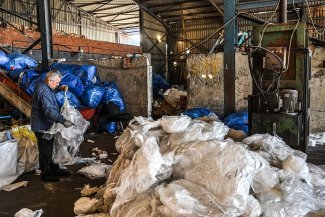
On 15 August, an anti-nuclear campaigner almost lost his foot during a demonstration in Bure, in the east of France. One month later, on 20 September, police conducted several raids on premises housing activists in the village, including the emblematic “Maison de la résistance”, (House of Resistance), the nerve centre of the fight against the nuclear dump.
The small village of Bure, in the Meuse department, has crystallised the anti-nuclear campaign in France in recent months. In 1998, it was selected as the site for an Industrial Geological Storage Centre (Cigéo), where the plan is to progressively bury 85,000 cubic metres of highly radioactive long-lived waste in a bed of clay, 500 metres below ground, by means of operations expected to last 150 years.
The ANDRA (National Agency for Radioactive Waste Management), which is managing the project, is expected to apply to the IRSN (the French Institute for Radioprotection and Nuclear Safety) for authorisation to build in 2019. Its application has been deferred on several occasions due to legal and technical setbacks, which could explain the growing hostility towards the anti-Cigéo activists.
In an open letter, the residents of Bure and the surrounding area recently denounced the “systematic strategy of tension and asphyxiation” launched by the state several months ago, a strategy “aimed at wearing us down and isolating us, like hunted beasts”.
The closer the project comes to the completion phase, the stronger the opposition, and the more the noose of repression is tightened around the anti-nuclear campaigners.
A far from satisfactory solution
The 54 nuclear reactors in France, the second largest producer of nuclear energy in the world, behind the United States, produce 12,000 to 15,000 cubic metres of radioactive waste every year. This includes both low level short-lived radioactive waste and much more toxic long-lived waste.
“The uranium industry, presented as a “virtuous cycle” by the nuclear lobby, actually conceals a chain of dirty, polluting and unmanageable fuel, from the mine to the waste disposal phase,” denounces the French anti-nuclear network Sortir du Nucléaire.
Whereas before, France used to dispose of its nuclear waste in repositories in the Atlantic Ocean, underground disposal now seems to be “the only management option”, says Matthieu Denis-Vienot, who is in charge of institutional dialogue at ANDRA, in an interview with Equal Times.
This agency was given the task, in 1979, of answering the insoluble question of how to manage this waste, which can be destroyed by no known chemical or mechanical means, and is extremely toxic.
“We have the technical capacity to store this waste in such a way that it is harmful neither to man nor to the environment, nor the object of malicious acts,” says Denis-Vienot. “Our priority is therefore focused on confining this waste, because we want to act responsibly and not to leave this burden with future generations.”
This option, although it has been written into French law since 1991 and is in line with the advice of the International Atomic Energy Agency (IAEA), is far from satisfactory, according to some researchers.
“Whether the waste is thrown into the sea or buried in the ground, the principle behind it is the same: get rid of it, so we can forget about it, because we don’t know what to do with it,” argues Jean-Marie Brom, a physicist and researcher with the CNRS (National Centre for Scientific Research). “What I can tell you as a scientist, is that burying it is the only solution, but it is far from being a good one.”
At ANDRA, the response to this is: “It’s all well and good to say it’s a heresy, but now that it’s there, what can we do about it?”
And that is the final argument put forward to the anti-Cigéo movement by ANDRA. The waste to be buried in Bure is all that generated by 43 years of nuclear energy production.
For the time being, it is being kept at the storage and reprocessing plant in La Hague, in the Manche department of France, where it is vitrified and placed in containers. It is a valid precaution, given that although this waste only represents four per cent of the total, it accounts for 99 per cent of the radioactivity emitted. Moreover, it is the waste with the longest lifespan. It takes 24,440 years for plutonium, for example, to lose half of its radioactivity.
The other 96 per cent of the waste, which accounts for one per cent of radioactivity, is stored on the surface, in the main, at two other storage centres, a few dozen kilometres from Bure.
Anti-nuclear campaigners are outraged by the situation. “It is far too dangerous. Firstly, it means that for 100 years, two radioactive convoys will cross France every day to come to Bure. And secondly, the safety of the site cannot be guaranteed when such long lifespans are involved. What will happen if, one day, these 200,000 “parcels” resurface, whilst they are still radioactive?” asks Jean-Marc Fleury, president of Eodra, a group of elected officials from the Grand Est region who are opposed to the Cigéo project.
The response from ANDRA is that geologists have conducted research and have established that the clay subsoil in the Meuse department of France is a stable geological formation over time.
The IRSN (French Institute for Radiological Protection and Reactor Safety), in its report from July, pointed to a number of risks, such as fire, and whilst acknowledging that the project had reached “satisfactory technical maturity”, it concluded that ANDRA’s current waste disposal concept “did not provide sufficient safety guarantees”.
The anti-nuclear campaigners highlight the example of the United States’ WIPP facility, in New Mexico, where a fire led to the release of radioactive gas, or that of Asse, in Lower Saxony, Germany, where 126,000 barrels of radioactive waste have to be evacuated from an old salt mine being eroded by seepage.
All these countries, confronted with the same problem, are far from having found long-term solutions, and face the same criticisms from the anti-nuclear movement.
Future of nuclear industry at issue
For those opposed to the Cigéo project, it is an ethical issue. “Since we know that collective memory is relatively short, it is possible that in a thousand years, it might be forgotten that it there is radioactive waste in Bure and people will go through these areas, with all the risks that entails,” explains Brom. “How can we warn future generations that there is extremely dangerous waste here?”
A whole new dimension is added when taking into account the waste to come from the nine reactors due to be decommissioned. And all the more so given that this number is expected to rise, with the Energy Transition Law, which envisages reducing the share of nuclear power in the country’s energy mix from 72 to 50 per cent by 2025.
The waste resulting from this decommissioning will have to be stored somewhere.
Beyond the unresolvable waste issue, the fight against the Cigéo project is part of a wider case against the nuclear industry in general. In a context where Germany has announced plans to close all of its nuclear power plants by 2022 and where Italy no longer has nuclear power, France stands out as an exception in the eyes of the activists.
“What is at stake in Bure, is the future of nuclear power,” says Fleury. “If the Cigéo is not built here, the nuclear industry will come to an end in the next ten years, because a project like this could never be implemented anywhere else, everyone is conscious of that. That’s why we are fighting: if we manage to stop it, it will mean the end of the industry. Regardless of how you look at it, nuclear power is an industry with no future.”
Denis-Viennot of ANDRA is not convinced by this line of reasoning. “The Cigéo has to be left out of the debate for or against nuclear power. We may not have chosen to launch the nuclear industry in France, but the fact is that, today, electricity comes mainly from this resource. Given the staggering lifespan of this radioactive waste, we can always question whether such or such a decision is legitimate, but that should not, nevertheless, reinforce indecision.”
So far, Nicolas Hulot, France’s new minister for the ecological transition, has not taken a stand.
The anti-Cigéo groups have, however, repeatedly reminded him of the positions he has taken in the past, including this photo from October 2016 of him posing, and smiling, with a placard against the Cigéo project.
But it seems that the new minister, who has taken off his environmental activist’s hat, has a short memory and is in no hurry to stop the project.








